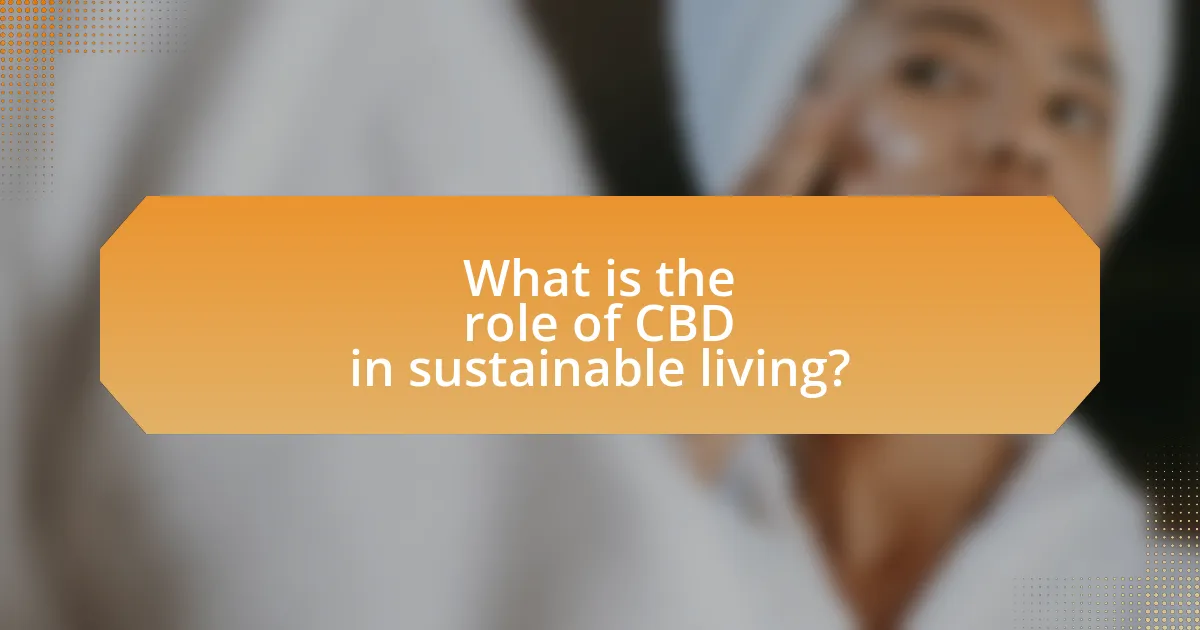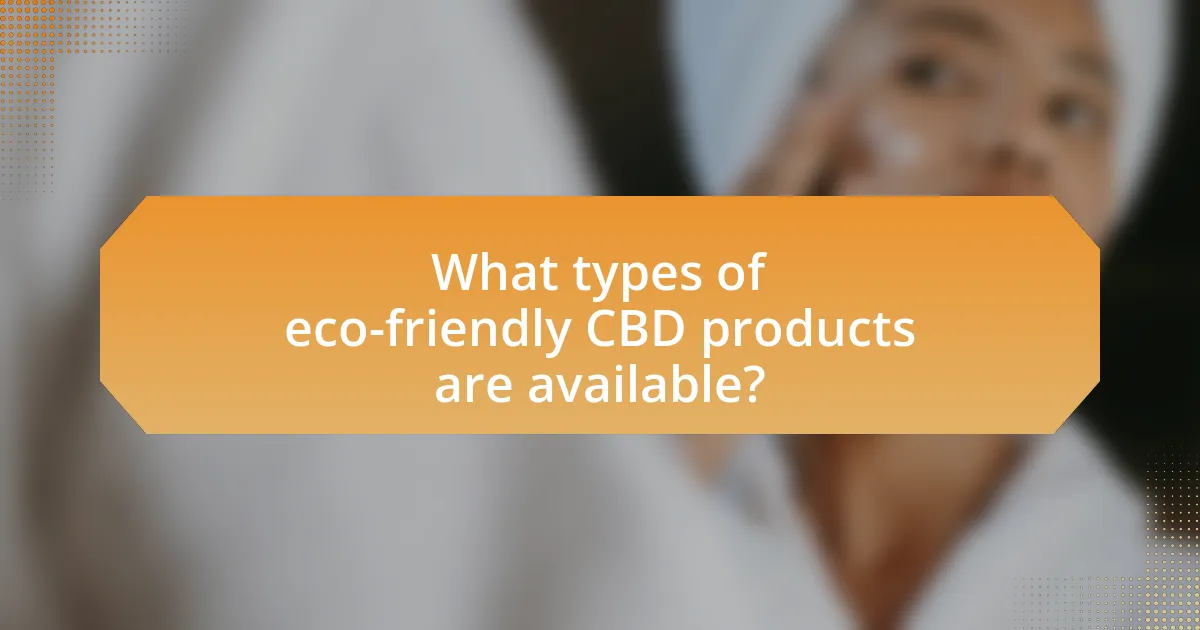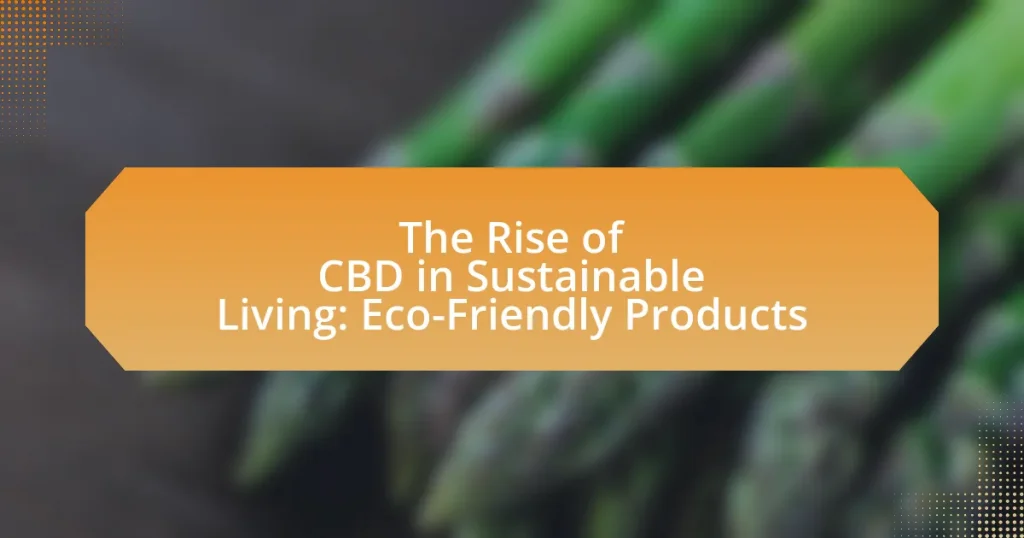The article focuses on the role of CBD in sustainable living, highlighting its eco-friendly alternatives in wellness and personal care products. It discusses the sustainable cultivation of hemp, which requires fewer pesticides and contributes to carbon sequestration, thereby mitigating climate change. The article also covers the sourcing of CBD from organic farms, the benefits of organic certification, and the environmental advantages of CBD over traditional materials. Additionally, it explores various eco-friendly CBD products, innovations in sustainable home goods, and best practices for consumers to make informed choices while minimizing waste.

What is the role of CBD in sustainable living?
CBD plays a significant role in sustainable living by providing eco-friendly alternatives to various products, particularly in the wellness and personal care sectors. The cultivation of hemp, from which CBD is derived, requires fewer pesticides and herbicides compared to traditional crops, making it a more sustainable agricultural choice. Additionally, hemp plants absorb carbon dioxide efficiently, contributing to carbon sequestration and helping mitigate climate change. Research indicates that hemp farming can improve soil health and biodiversity, further supporting sustainable practices. Thus, CBD not only offers health benefits but also promotes environmentally responsible production methods.
How is CBD sourced for eco-friendly products?
CBD is sourced for eco-friendly products primarily from organically grown hemp plants. These hemp plants are cultivated without synthetic pesticides or fertilizers, ensuring minimal environmental impact. The extraction process often utilizes methods such as CO2 extraction, which is considered environmentally friendly as it does not involve harmful solvents. Research indicates that organic farming practices can enhance soil health and biodiversity, further supporting sustainable agriculture. Additionally, many eco-friendly brands prioritize sourcing from local farms to reduce carbon footprints associated with transportation.
What farming practices are used in CBD cultivation?
CBD cultivation primarily utilizes organic farming practices, which include crop rotation, cover cropping, and integrated pest management. These methods enhance soil health, promote biodiversity, and reduce reliance on synthetic chemicals. For instance, organic farming practices have been shown to improve soil quality and increase the resilience of crops against pests and diseases, as supported by research from the Rodale Institute, which indicates that organic systems can yield comparable results to conventional methods while being more sustainable.
How does organic certification impact CBD production?
Organic certification significantly enhances CBD production by ensuring that the hemp used is grown without synthetic pesticides, herbicides, or fertilizers. This certification process not only promotes environmentally sustainable farming practices but also increases consumer trust and marketability of the CBD products. According to the USDA, organic farming practices can lead to healthier soil and ecosystems, which ultimately contribute to higher quality hemp. Additionally, studies indicate that organic CBD products often command higher prices in the market, reflecting consumer preference for organic and eco-friendly options.
Why is CBD considered a sustainable alternative?
CBD is considered a sustainable alternative primarily because it is derived from hemp, a crop that requires minimal resources to grow and can be cultivated in diverse environments. Hemp plants naturally improve soil health, require less water compared to traditional crops, and do not necessitate the use of harmful pesticides or herbicides. Furthermore, the cultivation of hemp contributes to carbon sequestration, helping to mitigate climate change. Studies indicate that hemp can absorb up to 22 tons of carbon dioxide per hectare, making it an effective tool for reducing greenhouse gas emissions. This combination of low resource requirements and environmental benefits positions CBD as a viable option in the pursuit of sustainable living.
What environmental benefits does CBD offer compared to traditional materials?
CBD offers significant environmental benefits compared to traditional materials, primarily due to its sustainable cultivation and lower resource requirements. Unlike conventional crops, hemp, from which CBD is derived, requires less water and no pesticides, reducing chemical runoff and conserving water resources. Additionally, hemp absorbs carbon dioxide more efficiently than many other plants, contributing to carbon sequestration and helping combat climate change. Research indicates that hemp can produce more fiber per acre than trees, making it a more sustainable option for textiles and other materials. These factors collectively highlight CBD’s potential to promote eco-friendly practices in various industries.
How does CBD contribute to reducing carbon footprints?
CBD contributes to reducing carbon footprints primarily through its cultivation practices, which can be more sustainable than traditional crops. Hemp, the plant from which CBD is derived, requires less water and no pesticides, leading to lower environmental impact. Additionally, hemp absorbs carbon dioxide from the atmosphere, potentially offsetting greenhouse gas emissions. Research indicates that hemp can sequester up to 22 tons of CO2 per hectare annually, making it a viable option for carbon reduction. Thus, the sustainable farming methods associated with CBD production play a significant role in minimizing carbon footprints.

What types of eco-friendly CBD products are available?
Eco-friendly CBD products include organic CBD oils, hemp-derived CBD edibles, biodegradable CBD capsules, and sustainably sourced CBD topicals. These products are made from hemp cultivated without synthetic pesticides or fertilizers, ensuring minimal environmental impact. For instance, organic CBD oils are derived from hemp grown in compliance with organic farming standards, which promotes soil health and biodiversity. Additionally, many brands utilize eco-friendly packaging, further reducing their carbon footprint.
How are CBD-infused personal care products made?
CBD-infused personal care products are made by extracting cannabidiol from hemp plants and incorporating it into various formulations. The extraction process typically involves methods such as CO2 extraction or ethanol extraction, which isolate CBD while preserving its beneficial properties. After extraction, the CBD is blended with other ingredients, such as oils, butters, and essential oils, to create products like lotions, balms, and shampoos. This method ensures that the final product retains the therapeutic benefits of CBD, which has been shown to have anti-inflammatory and moisturizing properties, making it suitable for personal care applications.
What ingredients are commonly used in CBD skincare products?
CBD skincare products commonly use ingredients such as cannabidiol (CBD), hemp seed oil, essential oils, shea butter, and aloe vera. Cannabidiol is the primary active ingredient derived from the hemp plant, known for its anti-inflammatory and antioxidant properties. Hemp seed oil is rich in fatty acids, which help moisturize and nourish the skin. Essential oils, like lavender and tea tree oil, are often included for their soothing and antibacterial effects. Shea butter provides deep hydration, while aloe vera is recognized for its calming and healing properties. These ingredients collectively contribute to the effectiveness and appeal of CBD skincare formulations.
How do CBD personal care products benefit the environment?
CBD personal care products benefit the environment by utilizing sustainable agricultural practices and biodegradable ingredients. The cultivation of hemp, from which CBD is derived, often requires fewer pesticides and herbicides compared to traditional crops, leading to reduced chemical runoff and soil degradation. Additionally, many CBD personal care brands prioritize eco-friendly packaging, which minimizes plastic waste. Research indicates that hemp can improve soil health and sequester carbon, further contributing to environmental sustainability.
What are the applications of CBD in sustainable home goods?
CBD is utilized in sustainable home goods primarily for its biodegradable properties and potential health benefits. Products such as CBD-infused textiles, biodegradable packaging, and eco-friendly cleaning supplies leverage CBD’s natural origins, promoting sustainability. For instance, CBD can be incorporated into fabrics to create antimicrobial properties, enhancing the longevity and safety of textiles. Additionally, CBD’s extraction process often involves fewer harmful chemicals compared to synthetic alternatives, aligning with eco-friendly practices. This application supports the growing demand for sustainable living solutions while providing consumers with health-conscious options.
How is CBD used in textiles and clothing?
CBD is used in textiles and clothing primarily for its potential therapeutic properties, such as anti-inflammatory and antimicrobial effects. Manufacturers incorporate CBD into fabrics through various methods, including infusing fibers with CBD oil or using CBD-infused dyes during the production process. This integration aims to enhance the comfort and functionality of clothing, offering benefits like skin soothing and odor control. Research indicates that textiles infused with CBD can provide additional value to consumers seeking wellness-oriented products, aligning with the growing trend of sustainable and eco-friendly living.
What innovations are emerging in CBD-based home products?
Innovations in CBD-based home products include the development of eco-friendly cleaning supplies, personal care items, and wellness products that incorporate CBD for its therapeutic benefits. For instance, companies are creating biodegradable cleaning agents infused with CBD, which not only clean effectively but also provide calming effects due to the cannabinoid’s properties. Additionally, personal care products such as lotions and soaps are being formulated with CBD to enhance skin health and provide anti-inflammatory benefits. The market for CBD-infused candles and home fragrances is also expanding, offering consumers aromatherapy benefits alongside the soothing properties of CBD. These innovations reflect a growing trend towards sustainable living, as many of these products are made from natural ingredients and packaged in environmentally friendly materials.

How can consumers make informed choices about CBD products?
Consumers can make informed choices about CBD products by researching product sourcing, understanding lab testing results, and verifying third-party certifications. Researching product sourcing ensures that consumers know whether the hemp is grown organically and sustainably, which is crucial for eco-friendly living. Understanding lab testing results allows consumers to confirm the potency and purity of the CBD, as reputable brands provide Certificates of Analysis (COAs) from independent labs. Verifying third-party certifications, such as USDA Organic or Non-GMO Project Verified, further assures consumers of the product’s quality and adherence to sustainable practices. These steps empower consumers to select CBD products that align with their values and health needs.
What should consumers look for in eco-friendly CBD products?
Consumers should look for third-party lab testing, organic sourcing, and sustainable packaging in eco-friendly CBD products. Third-party lab testing ensures that the product is free from contaminants and accurately labeled, providing transparency and safety. Organic sourcing indicates that the hemp is grown without synthetic pesticides or fertilizers, which is better for the environment and consumer health. Sustainable packaging, such as biodegradable or recyclable materials, minimizes environmental impact. These factors collectively contribute to the overall eco-friendliness of CBD products, aligning with sustainable living practices.
How can consumers verify the sustainability claims of CBD brands?
Consumers can verify the sustainability claims of CBD brands by examining third-party lab test results, certifications, and sourcing practices. Third-party lab tests provide unbiased verification of product contents and can confirm whether the cultivation methods align with sustainable practices. Certifications from recognized organizations, such as USDA Organic or Non-GMO Project Verified, indicate adherence to specific environmental standards. Additionally, consumers should investigate the sourcing of hemp, ensuring it is grown using sustainable agricultural methods, such as organic farming or regenerative practices, which are documented in industry reports and studies.
What certifications indicate a product’s eco-friendliness?
Certifications that indicate a product’s eco-friendliness include Energy Star, USDA Organic, Fair Trade, and Forest Stewardship Council (FSC). Energy Star certification signifies energy efficiency in appliances and electronics, reducing environmental impact. USDA Organic certification ensures that agricultural products are grown without synthetic pesticides or fertilizers, promoting sustainable farming practices. Fair Trade certification guarantees that products are sourced from producers who adhere to ethical labor practices and environmental sustainability. FSC certification indicates that wood and paper products come from responsibly managed forests, supporting biodiversity and forest conservation. These certifications provide consumers with reliable indicators of a product’s commitment to eco-friendliness.
What are the best practices for using CBD in sustainable living?
The best practices for using CBD in sustainable living include sourcing from organic farms, utilizing eco-friendly extraction methods, and opting for biodegradable packaging. Sourcing from organic farms ensures that the cultivation of hemp does not involve harmful pesticides or fertilizers, which can damage ecosystems. Eco-friendly extraction methods, such as CO2 extraction, minimize environmental impact by avoiding toxic solvents. Additionally, choosing products with biodegradable packaging reduces plastic waste, aligning with sustainable living principles. These practices contribute to a more environmentally responsible approach to CBD consumption, supporting both personal health and ecological well-being.
How can consumers incorporate CBD products into their daily routines sustainably?
Consumers can incorporate CBD products into their daily routines sustainably by choosing products that are sourced from organic hemp and packaged in eco-friendly materials. Organic hemp cultivation minimizes the use of harmful pesticides and fertilizers, promoting soil health and biodiversity. Additionally, selecting brands that utilize recyclable or biodegradable packaging reduces environmental impact. Research indicates that the hemp plant absorbs carbon dioxide, making it a sustainable crop that can contribute to carbon sequestration. By integrating these practices, consumers can enjoy the benefits of CBD while supporting sustainable agriculture and reducing their ecological footprint.
What tips can help consumers minimize waste when using CBD products?
To minimize waste when using CBD products, consumers should opt for products with minimal packaging and choose refillable or reusable containers. Selecting CBD brands that prioritize sustainable sourcing and eco-friendly materials can significantly reduce environmental impact. Additionally, consumers can practice proper dosage to avoid excess product waste, ensuring they use only what is necessary. Research indicates that sustainable practices in product design and consumer behavior can lead to a substantial decrease in waste generation, supporting the overall goal of eco-friendly living.



